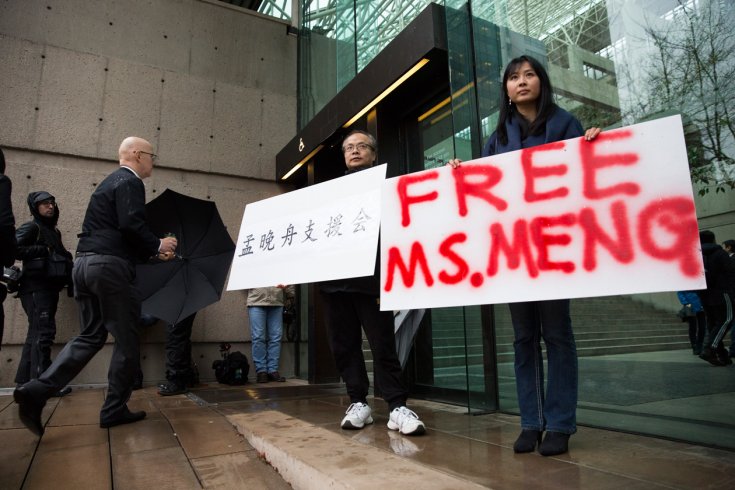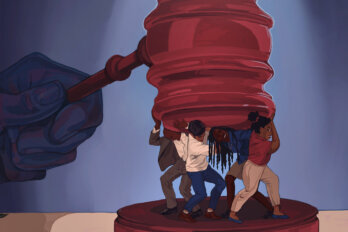It was a strange time to be Chinese and living in Canada in 2018. During that year, I felt a growing sense of disorientation that finally came to a head last December when Meng Wanzhou, chief financial officer of Chinese telecom giant Huawei was arrested by Canadian authorities, following an extradition request from the US, and charged with financial fraud. Canada did not comply with requests from China to release Meng. Shortly after, two Canadians were detained in China and currently stand accused of undermining China’s national security. Further developments saw the relationship between Canada and China grow increasingly tense. As a Chinese Canadian, one of my reactions to the news coverage of Meng’s arrest and its aftermath was to wonder what it might mean for how I’m perceived by other Canadians. Well before that story broke, I’d been getting mixed signals from news coverage of China, leaving me feeling destabilized.
Throughout the year, Canadian news media reported that China’s growing political power could not be ignored while I regularly encountered articles presenting stories of Chinese people struggling against discrimination. On the one hand, China was depicted a powerful land of economic promises—and threats—with a new class of globe-trotting ultrarich. On the other, the year brought stories of Chinese people fighting for better representation in Hollywood and against racism in the admissions process at Harvard University. To me, these two perspectives seemed to be at odds. One view presents Chinese people as capable of wielding immense power; the other presents Chinese people as disempowered victims of racism.
Of course, the Chinese people represented in these two views are not necessarily the same Chinese people, and a Chinese person can be simultaneously wealthy and subject to racism. But reading these news stories juxtaposed made me question how my own status in Canada was changing. I grew up with racial stereotypes that cast me as either an exotic geisha doll or a harmless nerd. Regardless of how I was characterized, I knew my default position was to be objectified by the people doing the stereotyping, according to their needs. I never imagined that one day, with the rise of China’s wealth, I would experience a new flavour of racial stereotyping: nowadays, I find Canadians trying to contort themselves around the imagined needs of someone who looks like me. While I’m still dismissed as a submissive geisha girl by some, I now command deferential smiles from hopeful sales associates in Saks assuming I’m a wealthy Chinese customer.
I began to ask how changing attitudes would affect me. Will I be praised as Canadian when I offer my tax returns, labour skills, and desirable cultural knowledge to this country and then demonized as a yellow foreigner when geopolitics favour China at the expense of Canadians—even when I am one of those Canadians affected? Will I be pressured into policing my own behaviour to appear like a safe “good” Chinese—a white-assimilated, liberalized Canadian—so that I am not branded a dangerous, usurping, antidemocratic, “bad” one? As I researched the history of how China and Chinese people have been viewed and represented, I came to realize none of these questions were new—and that I needed to radically reorient my own understanding of myself.
In February 2018, I was strolling through Toronto’s Yorkville neighbourhood, also known as the “Mink Mile” for its thoroughfare of luxury stores. As I passed by the large window displays, I noticed a conspicuous absence beginning with Louis Vuitton on the corner of Bloor and Avenue that continued right up to Holt Renfrew just east of Bay. Missing from Yorkville’s storefronts were the seasonal displays of pink and red hearts one might expect; last year, Chinese New Year fell two days after Valentine’s Day. Instead of roses and cupids, boutique windows were festooned with dogs, the Chinese zodiac animal of the year. This image, stripped of all context, was strikingly novel to me: in Toronto’s most expensive shopping district, decorations for a Chinese holiday had taken precedence over those named for a Christian saint.
This is the same city that was gripped by overt anti-Asian discrimination a mere fifteen years prior. In February 2003, the SARS outbreak hit Toronto. As SARS had originated in China, some feared it was being characterized in Canada as a “Chinese disease.” I remember reportage of racist incidents against Chinese Torontonians—the number of reports rose as the city battled a virus that would eventually claim forty-four lives in Ontario. The SARS Commission, an independent investigation created by the government of Ontario, would later reveal that Chinese and other Asian workers, particularly those in hospitality, were wrongfully dismissed from their jobs, Chinese businesses lost up to 80 percent of their income, and Chinese tenants faced discrimination from landlords.
The SARS outbreak was the first time I was confronted by the sense of simultaneously moving in opposite directions in society as a Chinese Canadian. It was around that time that the People’s Republic of China was showing signs of formidable development: it had recently joined the World Trade Organization, construction on the Three Gorges Dam was well underway, and its first manned spacecraft was set to launch. The competing realities of China’s rise and the discrimination I felt in Toronto as a Chinese Canadian made me feel as though I were both on my way up and down.
The year 2018 reintroduced that ambivalent feeling with greater intensity. Less than a month after witnessing Yorkville’s Chinese New Year window displays, another downtown Toronto neighbourhood prominently featured Chinese decorations. These decorations, however, were not designed to cater to Chinese clientele. In March, photos of an “Asian-themed” event at Wildflower, a downtown Toronto nightclub, were posted on Instagram and shared on my social-media feeds. They featured Wildflower staff dressed as pan-Asian caricatures: a squinting man with a Fu Manchu moustache and two women in midthigh kimonos with eating utensils thrust in their hair. Following criticism on social media, Wildflower issued a vague apology that did not address racism in any way.
Then, in August, amid stalled trade negotiations between Canada and China, I watched an old stereotype of Chinese people reemerge. Images of Asian people as vulgar, decadent, and immoral are a time-honoured tradition in Orientalist representations, and I found such images played to the hilt in Crazy Rich Asians, a Hollywood film starring a majority-Asian cast portraying a plutocratic family in contemporary Singapore. Following the film’s box-office success, celebratory narratives proliferated in the media, touting the story as a win for Asian representation.
The film seemed to mark an important cultural turning point. But as I began to consider historical representations of Asians, I realized it was not necessarily a positive one. In an interview last fall, Tony Wong, television critic at the Toronto Star, pointed out that images of rich Asians and a “rising China” are related to historical fears of Chinese people making bank while stealing jobs and resources. He warned me that images of rich, powerful Asians could invite a more negative reading—and that I should always ask whether they invoke the perception of yellow peril, a term scholars trace back to the late 19th century describing Asians as fearsome, threatening figures.
Another conversation, this one with Henry Yu, a history professor at the University of British Columbia, made me consider how orientalist depictions of Asians limited past narratives about China to its promise as a lucrative market on one hand while invoking a centuries-old “Asian invasion” narrative on the other, in which the West must protect itself and its values against foreign hordes of slavish barbarians. In descriptions of China, “what you have is vicious, vehemently anti-Chinese rhetoric sitting alongside hopeful opportunities . . . [such as] this idea of a Chinese market being good for business,” Yu told me. “From a historian’s point of view, those [narratives] have never been contradictory. . . . They have sat alongside each other constantly.”
My new sense of ambivalence was not so new after all. I had spent so long scrutinizing myself instead of challenging the scrutinizers. When I began my research last summer, I was still questioning how race would affect how I am perceived in Canada. By the time Meng was arrested in December, it was clear to me that I had fallen into a reactionary trap while analyzing current events and that I’d been asking the same questions that have been asked about Chinese people for over a century. In 1871, Harper’s Weekly published a cartoon by Thomas Nast titled “The Chinese Question.” It depicts a victimized Chinese man sitting below a litany of racist proclamations against him. A female white saviour figure, representing the US, protects him from an angry mob of white men carrying weapons. The title poses a question: How to view Chinese people? The answer always seems to be yellow peril or crazy rich Asians or model minority or whatever orientalist flavour of the week seems most convenient.
Twelve months after witnessing Yorkville’s Chinese New Year displays, I began to see yellow peril and its ilk as red herrings. Orientalist narratives and images promote a simplistic way of understanding today’s societal changes—including the influence of China’s rise on Canadians—that remains dangerously fixated on the more visible aspects of such changes. I often think about the evergreen concern over the growing presence of Chinese students in Canadian universities and the criticism of their conduct. In addition to marginalizing Chinese students, this narrow focus ignores the underlying factors that have led to the growing dependency of Canada’s schools on private sources of funding, such as international-student tuition. Such media coverage evades the responsibility to focus on trends that exist independent of the growth of international students on campus, such as declines in provincial funding, the erosion of academic freedom, and the downloading of the risk and cost of training workers onto universities by employers. Postsecondary institutions have become vulnerable to influences that are pushing them away from the interests of students, scholars, and the public good toward the interests of whoever wields the most power, whether it is a philanthropist with a pet project or corporations directing research and removing intellectual property from the public domain. But Chinese students aren’t responsible for that vulnerability, and they shouldn’t they be targeted for it.
Now, when I follow news about Sino-Canadian relations, I also consider how that coverage reflects on Canadian institutions instead of just how it affects Chinese people in Canada. Any analysis that falls prey to the seductive, simplified lens of a mythologized national identity or moralizing “clash of civilizations” narrative will remain superficial—making journalists, pundits, and other public commentators unable or unwilling to examine less visible systems of power that undergird the everyday lives of Canadians. Such an approach certainly will not contribute anything toward resolving current challenges in Sino-Canadian relations. Chinese people, or any ethnic group, are not a problem for Canadian society to puzzle through and solve. The question that needs to be asked is not, and has never been, the Chinese Question. What needs to be asked is, What is the Chinese Question hiding?





